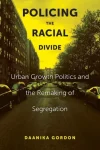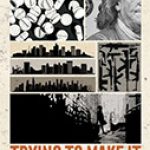Policing the Racial Divide: Urban Growth Politics and the Remaking of Segregation
 Author: Daanika Gordon
Author: Daanika Gordon
Publisher: NYU Press, 2022. 288 pages.
Reviewer: Jerald Podair | March 2023
In an unnamed Midwestern Rust Belt city, a graduate student studying the intersections of crime, race, and police work receives permission to “ride-along” with law enforcement officials as they patrol its streets and neighborhoods. “River City” is hyper segregated, with an overwhelmingly white East District separated by a river from an impoverished West District whose residents are predominantly people of color; in an effort to advance the goal of community policing, the city’s police districts had recently been reconfigured to correspond to these demographic patterns. Most of the officers the student travels with are from working or middle-class backgrounds (p. 219). About a third of the city’s police force is of color (p. 21).
The student comes to her study with a perspective, derived from “my own experiences and observations of racialization and years of studying race and ethnicity in the United States,” grounded in theories of “structural racism and enduring discrimination in contrast to colorblind explanations of inequality” (220). She observes few overt displays of racism during her travels with the police officers of River City. Generally, they deport themselves professionally, exhibit seriousness of purpose, and demonstrate a desire to serve and protect the public on both sides of the river.
Nonetheless, the student, now a professor of sociology, was deeply dissatisfied with what she saw. Her research, published in book form as Policing the Racial Divide: Urban Growth Politics and the Remaking of Segregation, recommends root-and-branch changes not only in the way River City policing is conducted but in the political, economic, and social mechanisms undergirding the city as a whole.
Policing the Racial Divide draws from a well-established historical narrative. River City responded to the migration north of thousands of African Americans beginning in the 1910s with policies which, while ostensibly race-neutral, established and enforced patterns of institutional bias and residential segregation. These included racially-disparate practices in federal home loan and mortgage insurance, urban renewal, public housing siting, real estate covenants, zoning, and highway construction. After World War II, deindustrialization coupled with employment discrimination and the failure of the public education system created almost impassable barriers to Black advancement. In the 1970s, as River City hemorrhaged unskilled and semi-skilled jobs, federal aid cratered, and New Deal and Great Society social safety net programs withered or expired, municipal officials turned to neoliberal policies of deregulation, privatization, and austerity. These, along with strict law enforcement and large-scale incarceration, served to disenfranchise, disempower, and marginalize the city’s Black population.
By the 2010s, when the author moved to River City to conduct her field research, the good intentions of the newly-appointed police commissioner and the men and women of his force were not enough: structure had prevailed. Even the most sympathetic and engaged officers could do no more than reinforce the existing inequities of resources, opportunities, and geography. East of the river, community-policing techniques fostered cooperative and friendly relations with law enforcement personnel. On the west side, crime-suppressive policies in Black and Brown neighborhoods created an atmosphere of resentment and hostility.
As River City attempted to revitalize its downtown core through “growth economics,” with its emphasis on entertainment, high-end residential development, creative-class entrepreneurship, and finance as engines of tax-base restoration and white-flight reversal, existing patterns of segregation and disinvestment were reified. City officials increasingly viewed the West District as a consumer of services and not a generator of wealth – as a taker, not a maker – and thus as unworthy of the tax abatements, subsidies, and protective services lavished on the “productive” East District white sectors. The racial rigidities imposed by growth economics even affected police perceptions of individuals found in the “wrong” neighborhoods in the form of the so-called “race out of place” syndrome, where Blacks found in the East District were considered potential criminals and whites in the west were assumed to be drug dealers.
The author is careful not to indict the officers of the River City police force individually, viewing them as products of history and as instruments and not active generators of oppressive structures and practices. No marauding Derek Chauvins, searching for George Floyds to target and murder, populate this book. Nonetheless, River City law enforcement officials, however dedicated and honest they might be as individuals, form one part of an interlocking institutional apparatus that separates, segregates, and discriminates. They occupy the ground floor of an edifice of inequity.
This is a history typical of many other twentieth-century American cities, especially those located in the post-industrial Rust Belt. But this book is a work of sociology, not history. The author’s contribution lies in her structuralist analysis of contemporary conditions and the remedies she offers. She admits – gingerly and with some prevarication about the accuracy of the statistics – that the crime rate in the West District is twice that of the East. Further, six times as many police calls involving “life-threatening” situations are made on the west side of the river (p. 86, 87, 112). Thus, she believes that police unfairly “frame” the West District as a hotbed of crime and argues that a “color-blind” approach to criminal activity, which focuses not on the identity of the perpetrator but on the act itself, is racially inequitable.
The author decries what she considers a lack of trust between West District residents and the police, exemplified by the “no-snitching” ethos which capitalizes on suspicion and fear. But she also wishes to see a reduction in violent crime on the west side, which may require harsh measures, including the stop-and-frisk and driving-while-Black pullovers that have inflamed police-citizen relations in cities all over the country. She wants law enforcement resources redirected from the East to the West District, but suggests that doing so might be interpreted as a form of framing or typecasting. Not doing so, on the other hand, could be viewed as a racially-motivated prioritization of white neighborhoods. The author does not want West District residents to feel neglected by the police, but also does not want them to feel targeted or abused. She wants the community-oriented, light-touch policing she sees on the east side transplanted to the west, but not at the price of allowing violent criminals to go unpunished. Even the decision to redraw River City’s police districts in order to unify the west side and encourage a sense of community is in almost the same breath praised as a conciliatory gesture and criticized as a form of stereotyping and discrimination.
It seems that virtually every policy road in River City leads to a cul-de-sac, and even the most well-meaning actions have racially inequitable consequences. The author argues convincingly that a continuance of the status quo, imprisoned by history and structure, is not a viable option. But neither is a concern with images, perceptions, and “frames” at the expense of what is visible and real. The people of River City’s West District are owed physical safety in their daily lives. Anything less is a denial of their humanity. The solution to the problem of “overpolicing and underprotection” – the bane of the West District, in the author’s view – is not clear. But it is not to be found in underpolicing. Black lives are every bit as valuable as white ones.
Perhaps the least-worst approach, under unpromising conditions that defy both history and structure, would be for police to go wherever violent crime occurs and stop it. Occam’s Razor had it right: sometimes we need to trust the wisdom of our own eyes.
Jerald Podair is a Professor of History and the Robert S. French Professor of American Studies at Lawrence University.


